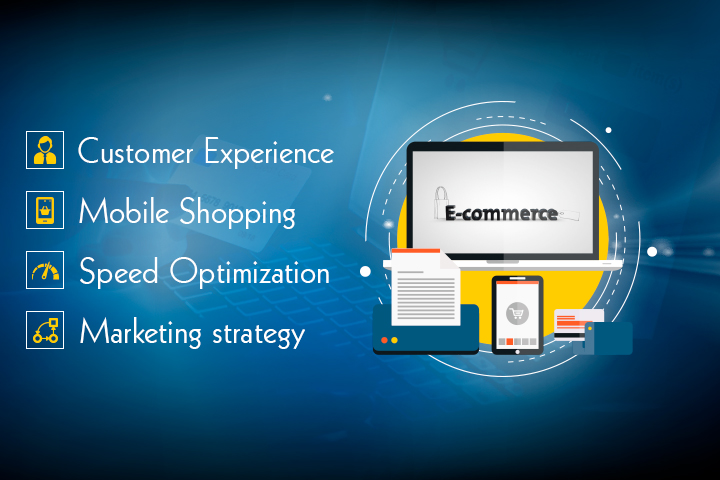One thing that brands tend to ignore but has a huge impact on their sales or awareness is the website layout and design. Just having good quality products and services isn’t enough; brands need to know that aesthetics have a huge role to play. Around 48% of users say that when they want to see the credibility of the brand, website design plays a huge part. And around 38% say that they don’t buy or stop engaging with the brand if they found the website difficult or not having a good design.
With the market getting saturated every minute, providing customers with an efficient user experience will make you stand out. Now is the right time to optimize your e-commerce website to increase sales and put a better image of your brand out there. To make this happen, you need to continuously keep an eye on the emerging trends in making websites easier to use.

Here are some steps that you can take to improve your e-commerce website.
1.Focus on Product Imagery
Why would people buy something that doesn’t even look good in pictures? Brands need to ask this question before launching their products. People wouldn’t want to buy something if the reference picture is pixelated, or is a huge render, or if there is no picture at all. These mistakes can be avoided so easily and are helpful in a huge way.
Brands should only use pictures on the website that are clear, have close to real colors, and aren’t heavy in size that takes forever to load. Use professional design software to compress pictures that don’t ruin the quality. But before this, brands need to focus on taking good pictures that show the right details of the product to the buyers.
2. Mobile Responsive Websites
The best thing you can do for your e-commerce website is to make it mobile-friendly, according to experts in the field. Statistics show that over 70% of online purchases will happen through a mobile phone. This is massive and brands need to pick up this trend and make websites easier not just for a laptop but for smartphones as well.
A mobile responsive website is going to look and work like an app and not like the traditional Chrome website. This makes it easier to be used on a phone or tablet. This also means that your customers can access and use the website from anywhere, they only need a gadget and a stable internet connection like Xtream Internet, and there they go. By doing so, conversion chances will increase.
3. Improve the Website Navigation
If there’s one thing that brands need to focus on the most, it’s website navigation. Making websites difficult means that it will take more time for people to find what they’re looking for. The more time it takes, the more likely it is for users to just quit the search and the brand will lose a potential sale. Making navigation easy means that people can reach the ‘confirm order’ tab quickly and also will come back for more shopping if their first experience went smoothly.
Putting oneself in the customer’s shoes will make these improvements easier to make. Make more categories on the page rather than throwing all the products on one page. These little improvements will have a huge effect on the customer experience and eventually on sales and brand recognition.

4. e-Commerce Hosting Provider
All the optimizations that you make on your website may not give desired results if you don’t have a good e-commerce hosting provider. There are several e-commerce hosting providers that more or less do the same job but with their differences, so you need to choose the one that fits your bracket. Some of the key features that you need to keep in mind are that the provider must give an updated and stable platform to your website.
It should be able to host plugins like WordPress and WooCommerce etc. The provider should also be optimized for speed and security features like built-in caching. It is after setting up your website on a good hosting provider that you should make further changes so they work.
5. Include Customer Feedback
A good way to tell new customers about the validity of your website is by showing them previous customer quotes. Website designers should find ways and places where customer feedback can be shown to people. This can be done on the main page or with separate products as well.
The feedback can be shown in the form of ratings, quotes, images, and even videos as well. What products are being bought from the website at the same time can be shown to customers as well. All these things increase the trust of people in the brand and website alike.
6. Analytics and Metrics
Analytics and metrics are essential components of any successful e-commerce website. By tracking data and analyzing key metrics, e-commerce businesses can gain insights into their website’s performance, customer behavior, and identify areas for improvement. In this section, we will discuss the importance of tracking analytics and metrics, key metrics to track, and tips for improving analytics and metrics.

Importance of Tracking Analytics and Metrics:
Tracking analytics and metrics provide valuable insights into the effectiveness of an e-commerce website. By monitoring metrics such as conversion rate, bounce rate, average order value, and customer lifetime value, businesses can make data-driven decisions to optimize their website’s performance and increase sales.
Key Metrics to Track:
Conversion rate measures the percentage of visitors who complete a desired action, such as making a purchase. Bounce rate measures the percentage of visitors who leave a website after viewing only one page. Average order value measures the average amount of money spent per order. Customer lifetime value measures the total value of a customer over their lifetime of purchases.
Tips for Improving Analytics and Metrics:
To improve analytics and metrics, businesses should use analytics tools, set goals, and regularly review and analyze data. Using tools such as Google Analytics can help track and analyze website traffic and performance. Setting specific goals can help businesses focus on key metrics and identify areas for improvement. Regularly reviewing and analyzing data can help businesses identify trends and make data-driven decisions to improve their website’s performance.
Conclusion
Focusing on your e-commerce website is a must if increasing sales and brand awareness is your goal. Make the above-mentioned changes and see the difference.

